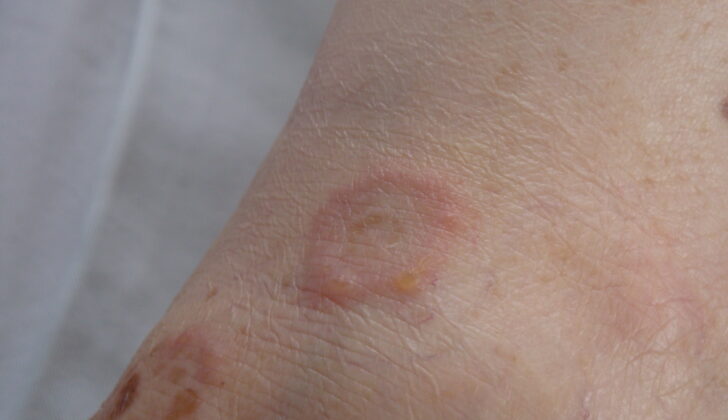What is Pemphigus Herpetiformis?
Pemphigus herpetiformis is a rare type of skin disease where blisters form in the upper layer of the skin due to an immune system disorder. This condition combines the physical symptoms of dermatitis herpetiformis and the immune system abnormalities found in pemphigus. The name “Pemphigus Herpetiformis” was suggested by Jablonska and colleagues in 1975, but this condition had been noticed before under various names including “dermatitis herpetiformis with acantholysis”, “mixed blistering disease”, and “pemphigus controlled by sulfapyridine.” Understanding these different terminologies can help you better comprehend this condition.
What Causes Pemphigus Herpetiformis?
Pemphigus herpetiformis is a skin condition that seems to be caused by an autoantibody, which is a kind of protein that the body mistakenly produces against its own cells. In this case, the autoantibody, known as IgG, mainly targets desmoglein proteins found in the skin’s outer layer. The exact process by which these autoantibodies create the typical skin lesions seen in pemphigus herpetiformis is still being researched.
Also, there have been instances where pemphigus herpetiformis has been caused by certain drugs. An autoantibody induced by medication is a reaction that occurs when the immune system mistakenly thinks the drug is a threat and creates antibodies against it.
Risk Factors and Frequency for Pemphigus Herpetiformis
Pemphigus herpetiformis, a type of pemphigus, constitutes approximately 6% to 7.3% of pemphigus cases. It was first identified in 1975, and since then, about 100 cases have been documented in scientific literature. This condition affects both men and women equally, and it can develop at any age, starting from when you’re as young as five to as old as 92. However, it’s important to note that only four cases have been reported in children. Additionally, pemphigus herpetiformis doesn’t seem to be more common in any one particular racial or ethnic group as it’s been found in people across different continents, including America, Europe, Asia, and Africa.
Signs and Symptoms of Pemphigus Herpetiformis
Pemphigus herpetiformis is a skin condition that usually begins subtly and may easily be mistaken for other diseases at first, such as dermatitis herpetiformis, bullous pemphigoid, or linear IgA bullous dermatosis. Symptoms generally include red, bumpy, blistering, pustular, or papular skin sores often in a group cluster, accompanied by severe itching. The rash usually shows a ring-like distribution due to the outward spread of inflammation.
- Red, bumpy, blistering, pustular, or papular skin sores
- Severe itching
- Ring-like rash distribution
In some cases, the main signs can be itchy hives and patches. These symptoms are not commonly seen in pemphigus vulgaris or pemphigus foliaceous, other forms of the disease. Pemphigus herpetiformis typically affects the body and upper extremities. It can show a widespread pattern but, occasionally, shows up as atypical and localized lesions. It’s important to note that it rarely affects mucous membranes. Over time, pemphigus herpetiformis can develop into pemphigus vulgaris or pemphigus foliaceous. The opposite transition has also been reported.
Testing for Pemphigus Herpetiformis
Some patients may show an increased number of eosinophils, a type of white blood cell, in their blood tests. A skin biopsy, which is when a small piece of skin is removed for testing, can be used to help confirm the diagnosis. In this test, a special coloration process called ‘direct immunofluorescence staining’ is used, which typically shows the presence of specific proteins, identified as IgG and C3, in the upper layers of the skin tissue. However, these proteins can sometimes be found in the lower layers, especially when there is a presence of specific antibodies called ‘autoantibodies’ against a protein called Dsg3.
Another testing method used is ‘indirect immunofluorescence’, where certain types of tissues like normal human skin, monkey or guinea pig esophagus or rat bladder are used to identify the binding of IgG antibodies. This indicates that the patient’s immune system is attacking their own tissues.
In addition, special tests like enzyme-linked immunosorbent assays and immunoblotting can also be used to check whether there are circulating antibodies in the body that are aimed at specific proteins in the skin, like Dsg1 and Dsg3, although more rarely. Recently, there have been reports of some other targeted proteins being found, such as Dsc1, Dsc3, 178-Kd antigen, BP 180 C-terminus, and laminin 332 gamma2 subunit.
Treatment Options for Pemphigus Herpetiformis
Pemphigus herpetiformis is generally a less severe form of an autoimmune skin disorder called pemphigus. Sometimes, however, it can develop into more serious types of pemphigus, known as pemphigus vulgaris or pemphigus foliaceous. Given the rarity of this condition, treatments are based on a limited number of cases.
Based on what doctors have observed, dapsone and corticosteroids are usually prescribed to manage the symptoms of pemphigus herpetiformis. Dapsone is usually the first treatment option because it can decrease the migration of neutrophils (a type of immune cell) which helps to reduce inflammation. Corticosteroids have also proven effective in treating pemphigus herpetiformis, with lower required doses compared to treatment for pemphigus vulgaris or pemphigus foliaceous. These drugs can be used alone or in combination.
In cases where pemphigus herpetiformis progresses to more severe types of pemphigus, or when the condition doesn’t respond to standard treatments (known as ‘recalcitrant’ cases), more aggressive treatment methods may be needed. These can include various types of strong medications, or procedures such as intravenous immunoglobulin (where antibodies are supplied to the body to slow the immune system attack on the skin), rituximab (a drug that targets certain blood cells), plasmapheresis (a procedure which filters the blood), and others.
What else can Pemphigus Herpetiformis be?
The following are various skin conditions that could be mistaken for each other due to their similar symptoms. They include:
- Bullous pemphigoid
- Erythema multiforme
- Excoriation disorder
- Familial benign pemphigus
- IgA pemphigus
- Linear IgA dermatosis
- Papular urticaria
- Paraneoplastic pemphigus
- Pemphigus erythematosus
- Pemphigus foliaceus
- Scabies
It’s crucial for medical professionals to identify these correctly for effective treatment.












